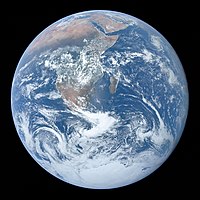
Photo from wikipedia
Topological effects may direct ocean and atmospheric waves near the equator Equatorial Kelvin waves occur constantly in Earth's atmosphere and ocean. They constitute an isolated and powerful component of the… Click to show full abstract
Topological effects may direct ocean and atmospheric waves near the equator Equatorial Kelvin waves occur constantly in Earth's atmosphere and ocean. They constitute an isolated and powerful component of the observed atmospheric wave spectrum (1), whereas oceanic Kelvin waves drive up- and downwelling in the Pacific Ocean thermocline, which affects the El Niño–Southern Oscillation. In the atmosphere, Kelvin waves are initiated by and coupled to convective activity (storm systems), mostly over the Indian and the western Pacific Oceans, whereas in periods of large-scale convective organization, such as the Madden-Julian Oscillation, equatorial Kelvin wave activity is suppressed. On page 1075 of this issue, Delplace et al. (2) attempt to answer the questions of why there are three equatorially confined waves, and why they all have eastward group velocity. They propose a fascinating perspective on the existence of unidirectional, equatorially confined atmospheric waves by developing an analogy with similar phenomena that occur in electronic materials—in particular, in quantum Hall states and topological insulators.
Journal Title: Science
Year Published: 2017
Link to full text (if available)
Share on Social Media: Sign Up to like & get
recommendations!